.Net框架搭建之1SQL Server EF MVC简单三层框架
Posted 真爱无限
tags:
篇首语:本文由小常识网(cha138.com)小编为大家整理,主要介绍了.Net框架搭建之1SQL Server EF MVC简单三层框架相关的知识,希望对你有一定的参考价值。
.Net简单三层框架简介
简单三层框架,是.Net开发中最最基础的框架了,由 数据访问层、逻辑处理层、表示层组成。一般情况下,在项目中数据模型Model层也是单独一层,但是只是单纯的数据模型不算在业务层划分当中。
好了,框架搭建,如果不了解,可能会觉得难以下手,了解之后,自然知道怎么做,只是其中的步骤,比起单纯的功能开发,是要繁琐不少,下面我们来一步一步搭建属于自己的框架,这里只列出重要步骤,其他未提到的细节可自行摸索。
数据模型Model层创建
数据模型层,首先要创建数据库,再从数据库生成EF模型。
创建数据库,表,添加一条测试数据
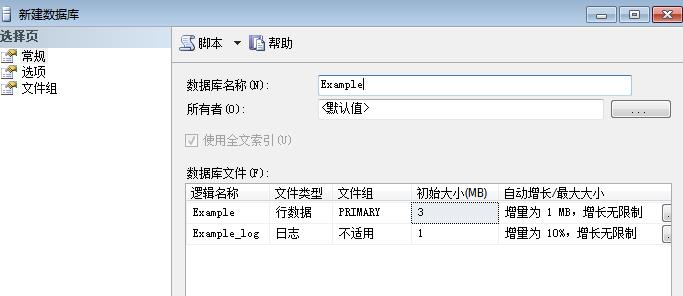
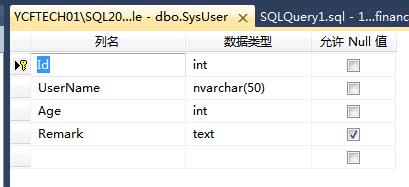

新建类库,添加实体数据模型,连接数据库,获取表结构到实体模型
首先,添加类库 ,名称:Example.Model
再添加实体数据模型:
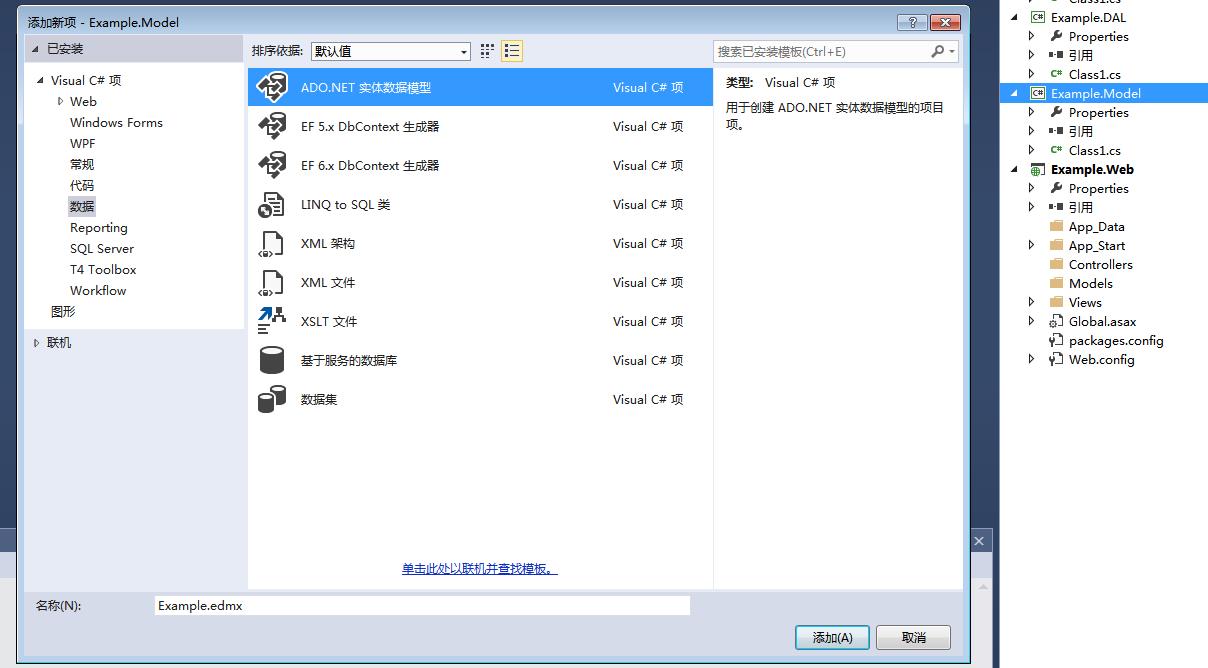
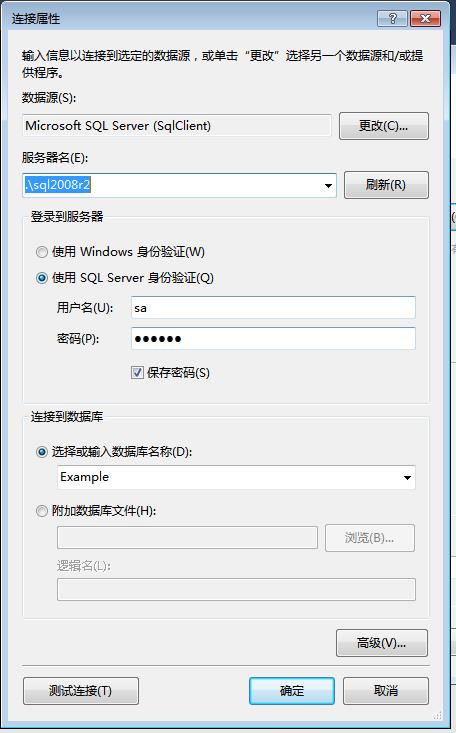
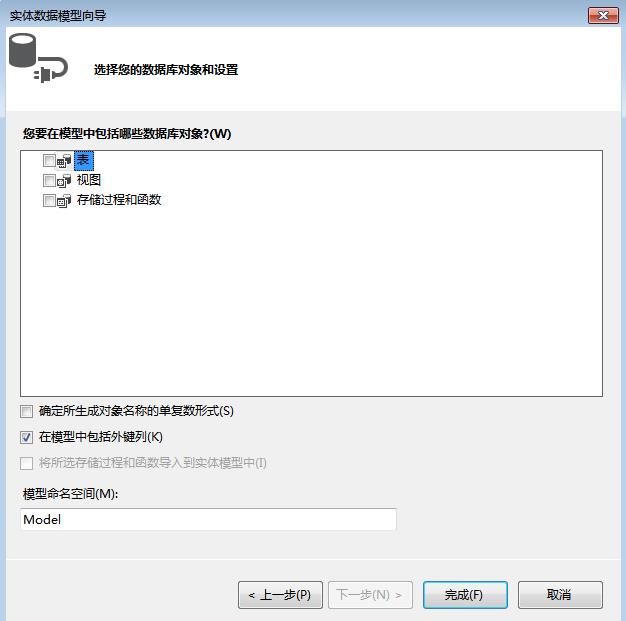

至此,Model数据层算了完成了。
DAL数据访问层创建
由于我们事件知道有几层,所以,先把所有的类库项目全部先建立好,web为MVC的空项目,至于各层代码,分到各层再去处理
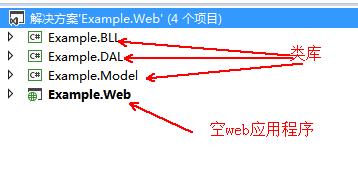
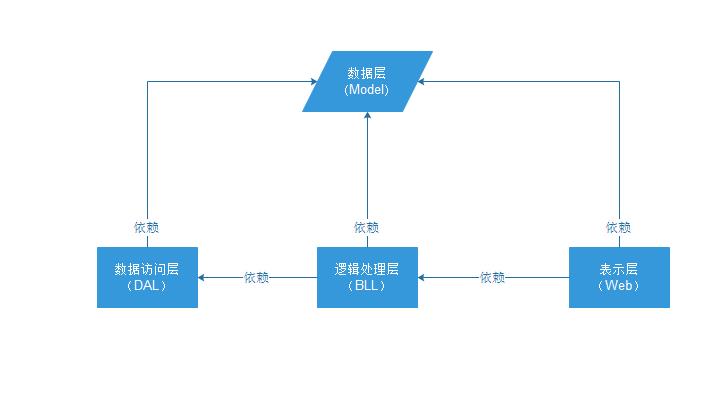
由于使用EF,为了方便使用EF扩展,先用nuget添加一个扩展包
EntityFrameWork.Extended,版本使用默认的就行。

添加好之后,就可以添加一个BaseDAL的类了,是为了方便DAL层操作的。
BaseDAL.cs
using System;
using System.Collections.Generic;
using System.Data.Entity;
using System.Linq;
using System.Linq.Expressions;
using System.Text;
using System.Threading.Tasks;
using EntityFramework.Extensions;
using Example.Model;
namespace Example.DAL
{
public class BaseDAL<T> where T : class
{
private ExampleEntities _db = null;
public ExampleEntities db
{
get
{
if (_db == null) _db = new ExampleEntities();
return _db;
}
}
public virtual IQueryable<T> Entities
{
get { return db.Set<T>().AsNoTracking(); }
}
public virtual IQueryable<T> Table
{
get { return db.Set<T>(); }
}
public IList<T> GetAll(Expression<Func<T, bool>> exp)
{
var query = db.Set<T>().Where(exp).AsNoTracking();
IList<T> data = query.ToList();
return data;
}
public int Add(T model)
{
try
{
EntityState state = db.Entry(model).State;
if (state == EntityState.Detached)
{
db.Entry(model).State = EntityState.Added;
}
//db.Set<T>().Add(model);
return db.SaveChanges();
}
catch (System.Data.Entity.Validation.DbEntityValidationException ex)
{
string errmsg = "";
foreach (var item in ex.EntityValidationErrors.First().ValidationErrors)
{
errmsg += item.ErrorMessage + " ; ";
}
throw new Exception(errmsg);
}
finally
{
}
}
/// <summary>
/// 批量添加
/// </summary>
/// <param name="models"></param>
/// <returns></returns>
public int AddCollect(List<T> models)
{
try
{
foreach (T model in models)
{
EntityState state = db.Entry(model).State;
if (state == EntityState.Detached)
{
db.Entry(model).State = EntityState.Added;
}
}
//db.Set<T>().Add(model);
return db.SaveChanges();
}
catch (System.Data.Entity.Validation.DbEntityValidationException ex)
{
string errmsg = "";
foreach (var item in ex.EntityValidationErrors.First().ValidationErrors)
{
errmsg += item.ErrorMessage + " ; ";
}
throw new Exception(errmsg);
}
finally
{
}
}
public int Edit(T model)
{
try
{
try
{
db.Set<T>().Attach(model);
}
catch { }
db.Entry(model).State = EntityState.Modified;
return db.SaveChanges();
}
catch (System.Data.Entity.Validation.DbEntityValidationException ex)
{
string errmsg = "";
foreach (var item in ex.EntityValidationErrors.First().ValidationErrors)
{
errmsg += item.ErrorMessage + " ; ";
}
throw new Exception(errmsg);
}
finally
{
}
}
/// <summary>
/// 批量修改
/// </summary>
/// <param name="models"></param>
/// <returns></returns>
public int EditCollect(List<T> models)
{
try
{
foreach (T model in models)
{
try
{
EntityState state = db.Entry(model).State;
db.Set<T>().Attach(model);
}
catch { }
db.Entry(model).State = EntityState.Modified;
}
return db.SaveChanges();
}
catch (System.Data.Entity.Validation.DbEntityValidationException ex)
{
string errmsg = "";
foreach (var item in ex.EntityValidationErrors.First().ValidationErrors)
{
errmsg += item.ErrorMessage + " ; ";
}
throw new Exception(errmsg);
}
finally
{
}
}
/// <summary>
/// 修改操作,可以只更新部分列,效率高
/// </summary>
/// <param name="funWhere">查询条件-谓语表达式</param>
/// <param name="funUpdate">实体-谓语表达式</param>
/// <returns>操作影响的行数</returns>
public virtual int Edit(Expression<Func<T, bool>> funWhere, Expression<Func<T, T>> funUpdate)
{
return Entities.Where(funWhere).Update(funUpdate);
}
public int Delete(T model)
{
try
{
db.Configuration.AutoDetectChangesEnabled = false;
db.Entry(model).State = EntityState.Deleted;
db.Configuration.AutoDetectChangesEnabled = true;
return db.SaveChanges();
}
catch (System.Data.Entity.Validation.DbEntityValidationException ex)
{
string errmsg = "";
foreach (var item in ex.EntityValidationErrors.First().ValidationErrors)
{
errmsg += item.ErrorMessage + " ; ";
}
throw new Exception(errmsg);
}
finally
{
}
}
public int DeleteExp(Expression<Func<T, bool>> exp)
{
try
{
var q = db.Set<T>().Where(exp);
db.Configuration.AutoDetectChangesEnabled = false;
db.Set<T>().RemoveRange(q);
db.Configuration.AutoDetectChangesEnabled = true;
return db.SaveChanges();
}
catch (System.Data.Entity.Validation.DbEntityValidationException ex)
{
string errmsg = "";
foreach (var item in ex.EntityValidationErrors.First().ValidationErrors)
{
errmsg += item.ErrorMessage + " ; ";
}
throw new Exception(errmsg);
}
finally
{
}
}
}
}
有了BaseDAL这个类,我们就来建立具体针对表的 SysUserDAL.cs
SysUserDAL.cs
很简单,我们就写个方法读取数据库中之前添加的一条测试数据
using System;
using System.Collections.Generic;
using System.Linq;
using System.Text;
using System.Threading.Tasks;
using System.Data.Entity;
namespace Example.DAL
{
public class SysUserDAL : BaseDAL<SysUser>
{
public SysUser GetUserById(int id)
{
return Entities.Where(o => o.Id == id).FirstOrDefault();
}
}
}
BLL逻辑处理层创建
在Example.BLL 项目中,添加 Example.BLL.cs
Example.BLL.cs
using Example.DAL;
using Example.Model;
using System;
using System.Collections.Generic;
using System.Linq;
using System.Text;
using System.Threading.Tasks;
namespace Example.BLL
{
public class SysUserBLL
{
private SysUserDAL _dal = null;
public SysUserDAL dal
{
get
{
if (_dal == null) _dal = new SysUserDAL();
return _dal;
}
}
public SysUser GetUserById(int id)
{
return dal.GetUserById(id);
}
}
}
BLL层内容也就完成了
BLL层就这么简单,如果不做数据方面的判断,直接调用DAL层的方法就行
MVC Web 表示层处理
先简单修改一下默认路由
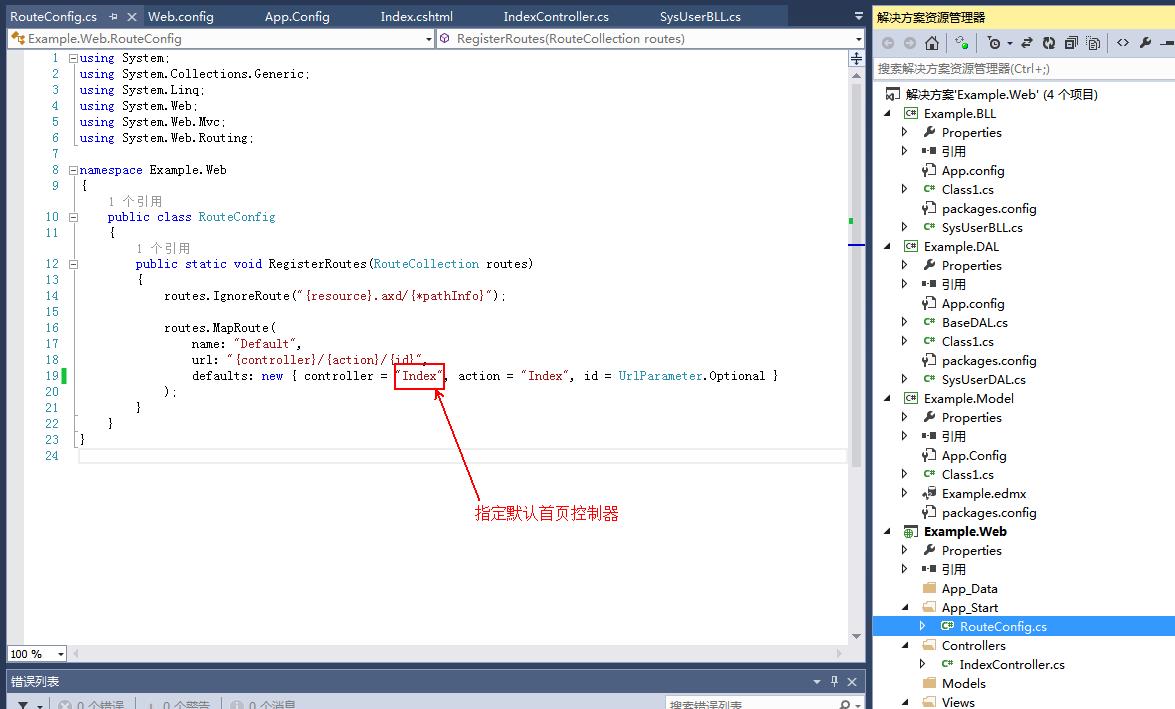
创建首页控制器和页面Razor视图
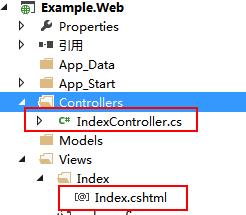
Index控制器中修改action为Index的方法
private SysUserBLL _BLL = null;
public SysUserBLL BLL
{
get
{
if (_BLL == null) _BLL = new SysUserBLL();
return _BLL;
}
}
//
// GET: /Index/
public ActionResult Index()
{
ViewBag.FirstUser = BLL.GetUserById(1);
return View();
}Index.cshtml页面显示的修改
@{
Layout = null;
var model = ViewBag.FirstUser as Example.Model.SysUser;
}
<!DOCTYPE html>
<html>
<head>
<meta name="viewport" content="width=device-width" />
<title></title>
</head>
<body>
<div>
姓名:@(model!=null?model.UserName:"空")
</div>
</body>
</html>
运行效果:
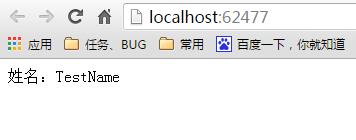
此文章一步一步介绍如果搭建简单三层 ef mvc框架项目,关键流程和代码都已贴上,按步骤来应该可以正常运行,如果不能正常运行,可以同我交流,可以加补一些更详细的步骤。
后续会加上另外几种框架。
版权声明:
作者:真爱无限
出处:http://blog.csdn.net/pukuimin1226/
本文为博主原创文章版权归作者所有,欢迎转载,但未经作者同意必须保留此段声明,且在文章页面明显位置给出原文链接.
以上是关于.Net框架搭建之1SQL Server EF MVC简单三层框架的主要内容,如果未能解决你的问题,请参考以下文章